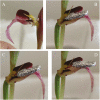Pollination mechanism in Serapias with no pollinaria reconfiguration
- PMID: 37899971
- PMCID: PMC10601389
- DOI: 10.1093/aobpla/plad054
Pollination mechanism in Serapias with no pollinaria reconfiguration
Abstract
Orchidaceae, one of the most numerous families in the world's flora, have evolved various pollination strategies to favour cross-pollination, such as deceptive pollination and pollinarium reconfiguration. Among the terrestrial orchids of the Mediterranean, only species belonging to the genus Serapias show a strategy defined as shelter imitation. The floral elements form a tubular structure that insects use during their resting phases. The purpose of this article was to clarify the mechanisms that guarantee pollination with particular attention to the morphological interactions between orchids and pollinators and whether pollinaria reconfiguration is necessary in the promotion of cross-pollination in Serapias. Breeding system experiments and hand-pollination treatments indicated that Serapias was highly self-compatible, shows low value of natural fruit set and is pollinator limited. Time-lapse photos showed that the pollinarium had no refolding of the stipe or caudicle after its removal from the flower. The morphology of the flower determined the attack of the pollinarium on the occiput/vertex of insect. When the insect left the flower, the pollinarium was unable to encounter the stigma. When the insect made a second visit to another flower, the pollen masses of the first pollinarium ended up on the stigma and at the same time, the insect picked up a second pollinarium. Our observations and analyses suggested that morphological interactions between flower and pollinator are crucial to the success of pollination and to prevent self-pollination and thus that pollinarium reconfiguration is unnecessary in shelter deceptive orchids, such as Serapias species, for the promotion of cross-pollination. Serapias represent a case of interactions between plant and pollinator; the formation of the tubular shape of the flower is an essential preadaptation for the development of resting site mimicry originating exclusively in Serapias among Mediterranean orchids.
Keywords: Breeding system; Serapias; orchids; pollinaria reconfiguration; pollination; reproductive biology.
© The Author(s) 2023. Published by Oxford University Press on behalf of the Annals of Botany Company.
Conflict of interest statement
None declared.
Figures




References
-
- Barone Lumaga MR, Pellegrino G, Bellusci F, Perrotta E, Perrotta I, Musacchio A.. 2012. Comparative floral micromorphology in four sympatric species of Serapias (Orchidaceae). Botanical Journal of the Linnean Society 169:714–724.
-
- Bellusci F, Pellegrino G, Palermo AM, Musacchio A.. 2008. Phylogenetic relationships in the orchid genus Serapias L. based on non-coding regions of the chloroplast genome. Molecular Phylogenetics and Evolution 47:986–991. - PubMed
-
- Bellusci F, Pellegrino G, Palermo AM, Musacchio A.. 2010. Crossing barriers between the unrewarding Mediterranean orchids Serapias vomeracea and S. cordigera. Plant Species Biology 25:68–76.
-
- Borba EL, Semir J.. 1999. Temporal variation in pollinarium size after its removal in species of Bulbophyllum: a different mechanism preventing self-pollination in Orchidaceae. Plant Systematics and Evolution 217:197–204.
LinkOut - more resources
Full Text Sources

